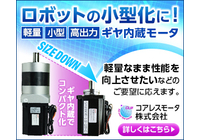What is a coreless motor?? #CorelessMotor #BasicKnowledgeMaterial
What exactly is a coreless motor? I will explain it briefly. I will discuss the differences in appearance, the operating principles, as well as the advantages and disadvantages.
This is basic knowledge information that provides a simple explanation of coreless motors. A coreless motor is a type of motor that does not have an iron core, which makes it compact and lightweight. Products manufactured with coreless motors include vibration motors for mobile phones and linear motors that control the autofocus function in smartphones. It may not be an exaggeration to say that we are constantly relying on coreless motors without even realizing it. Devices like earphones and speakers are also referred to as voice coil-type coreless motors, indicating that coreless motors are present in many aspects of our lives. However, core motors are overwhelmingly more manufactured and used, with over 95% of motors in the world being core motors. The reason for this is that while coreless motors are suitable for ultra-precision applications, they are said to be unsuitable for high-power applications. We are developing and manufacturing coreless motors that defy the common understanding of typical coreless motors.
basic information
According to Wikipedia, a coreless motor (also known as a coreless electric motor) is a type of permanent magnet field commutated motor that features a cup-shaped armature with windings solidified only with resin and incorporates permanent magnets for the field. As the name suggests, it lacks a core (iron core), theoretically eliminating iron losses that would occur. However, this makes it challenging to generate large torque. In recent years, the emergence of powerful neodymium magnets has led to the development of various types of coreless motors, but currently, only small-sized models have been put into practical use. Features: - The mass of the armature is light, and the mechanical time constant is small (suitable for rapid acceleration and deceleration due to low inertial mass). - The inductance of the windings is low, resulting in small sparks during commutation. - Cogging-free. - Capable of achieving high efficiency.
Price range
Delivery Time
Applications/Examples of results
- Autofocus linear motor - Mobile phone vibration motor - Drive motor for high-end model trains - Servo motor for remote control, robots, etc. - Earphones - Speakers - Linear motor
catalog(2)
Download All CatalogsRecommended products
Distributors
Coreless motors are engaged in the development, manufacturing, and sales of precision small motors, generators, and drivers, offering a wide range of products specialized in lightweight and energy-saving technologies through proprietary technology. 【Product Lineup】 - Coreless Brushless DC Motors - Cored Brushless DC Motors (ODM) - Small Geared Motors (ODM) - General-purpose Geared Motors (some ODM) - Gear-integrated Motors (Winner of the 36th Kanagawa Prefectural Industrial Technology Development Award) - In-wheel Motors for Electric Wheelchairs - Wheel Servo Motors (ODM) - Brushless Motor Drivers (some OEM) - Battery-powered AC Servo Motors (some ODM) - AC Servo Motion Controllers (ODM) - Renewable Energy Generators (some ODM) - Wind Turbines with EAT - IC Fan Motors - Conventional Axial Flow Fan Motors (ODM) - DC Blower Fan Motors (ODM) - Linear Motors













































